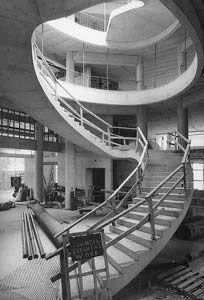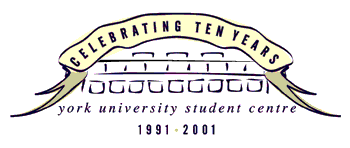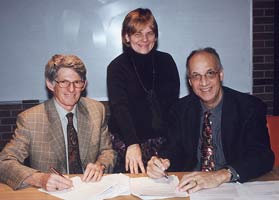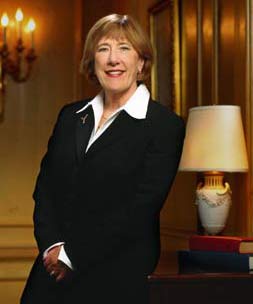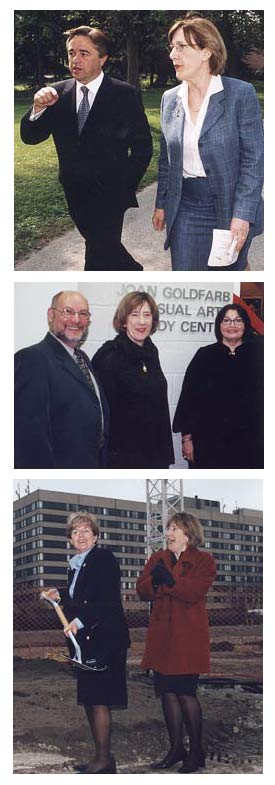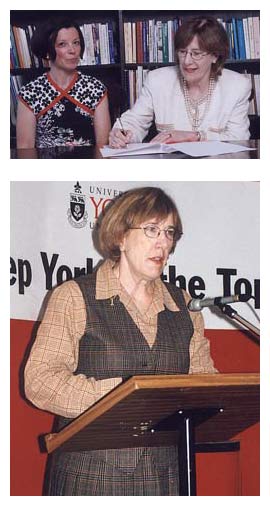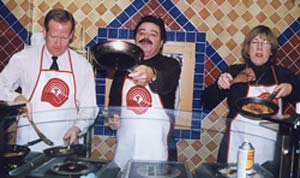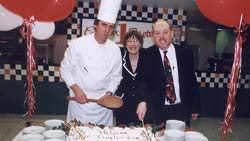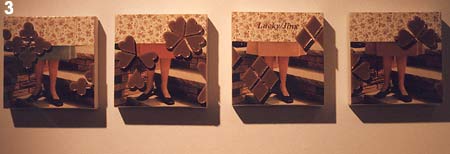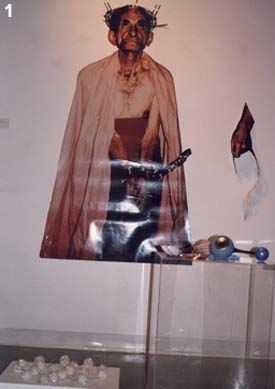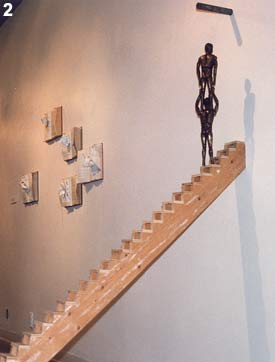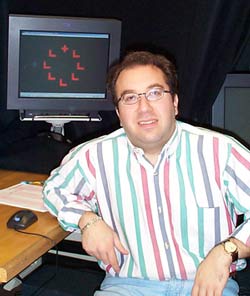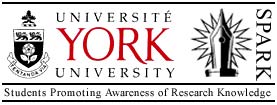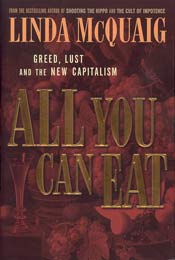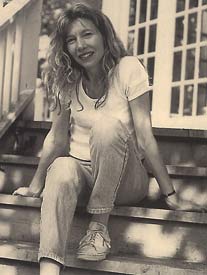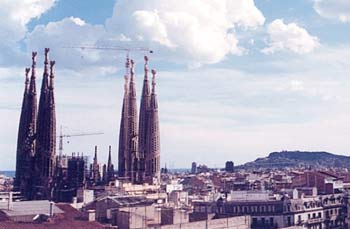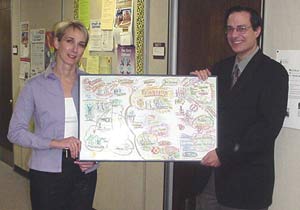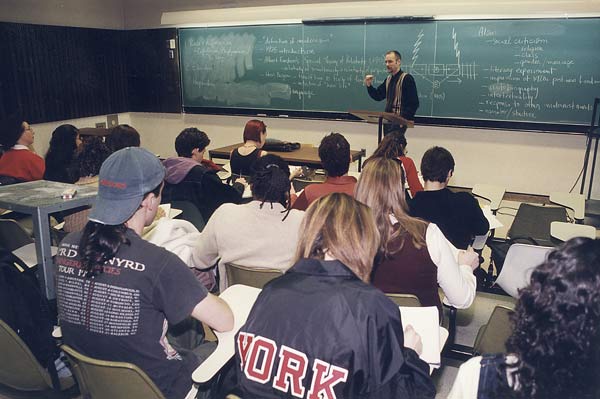|
|||||||||||||||||||||||||||||
|
|
|||||||||||||||||||||||||||||
| | |
| | VOLUME 32, NUMBER 11 | WEDNESDAY, JANUARY 23, 2002 | ISSN 1199-5246 | |
| | |||
|
 |
By Martha Tancock 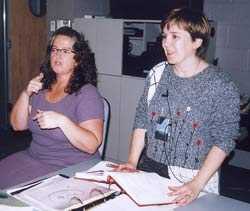
Freelance interpreter Glenice McKnight translates into American Sign Language audiologist Pam Millett's lecture to future teachers of the deaf and hard of hearing. Millett wears a transmitter that will send her words to those wearing FM receivers in this Vari Hall room specially equipped to serve deaf and hard-of-hearing students. Audiologist Pam Millett speaks at the front of the classroom dedicated to training teachers of the deaf and hard of hearing at York. To her left, a woman is seated on a stool, her hands busy translating Millett's lecture into American Sign Language. To her right, a verbatim court reporter types her words for instant replay in giant scrolling script on desktop monitors. Around her, the walls are baffled to reduce sound reverberations. Above her, infrared and FM sensors dangle from the ceiling, picking up her words and transmitting them to students belted with receivers, fitted with hearing aids or cochlear implants. The lighting is soft to reduce eye strain, because much depends on sight here. If you are deaf or hard of hearing, you will have no excuse for missing one word in this room off the Vari Hall rotunda. Attending class this October afternoon are 15-20 certified teachers taking 10 extra months to qualify to teach deaf and hard-of-hearing children. Some are fresh graduates, some have more than 20 years experience. Many are deaf or hard of hearing themselves. None will have any trouble finding placements in Ontario or, indeed, anywhere in the English-speaking world. During the 1970s and 1980s, the numbers of deaf and hard-of-hearing children rose in Ontario due to mothers who had contracted rubella (German measles) when they were pregnant. The population of students with hearing loss has reduced to a normal level now, but demand for deaf education teachers remains high. In Ontario, teachers can find jobs at three schools for the deaf, in school board classes for the deaf or hard of hearing, or as itinerant support for hearing-loss students fully integrated into the public school system. Program coordinator Barry Denman says he could find placements in Ontario alone for double the 20 or so graduates every year. "Demand always exceeds supply even in times of teacher surplus," says Denman. "It's hard to find people who will give up a whole year's salary" to get the additional credentials - and sometimes no increase in pay. That's why tuition is free. Students pay $50 to apply and $350 for materials. The rest is funded under a Special Purpose Grant by the Ministry of Training, Colleges and Universities. York offers the only full-time Deaf Education Program in Ontario and the biggest one of four in Canada. The University's Faculty of Education took over the program from the Ministry of Education 10 years ago. The faculty is small - two tenured professors, one full-time, seasoned teacher of the deaf and nine part-time contract course directors. The Deaf Education Program is two months longer than the standard teacher training programs because "there is so much information, a different skill set in terms of teaching and a different attitude to education of deaf and hard of hearing," says Denman. "Like their hearing peers, most hearing-impaired students are intellectually quite normal," says Denman. "For some, they just communicate in a different language. For others, they have significant impairment and that means academic progress can be more difficult." All teachers take a minimum of sign language because their students will sometimes use all ways - visual and oral - to communicate, says Denman. From September to the following June, they take 17 half courses and spend nine weeks doing supervised practice teaching. They study American Sign Language, hearing loss and amplification systems, oral and auditory-verbal communication, language and literacy development, teaching in mainstream settings and bilingual-bicultural education. By spring they are specializing. Those registered in the Deaf Education Program come from all over the province. York's Faculty of Education offers a fully accessible bachelor of education program for deaf and hard-of-hearing students who need supports - such as notetaking and interpreting services - to get their initial teacher certification. Spaces are also reserved just for them in undergraduate American Sign Language classes. It's York's way of addressing the need. "We grow our own," says Denman.
| ||
|
 |
By Jeff Zoeller 
Student Centre under construction York University is a unique place; and so it should come as no surprise that its Student Centre is just as unique. The Student Centre was born of the need to provide a space where York students could congregate, socialize, organize and generally relax from the academic rigours of university life. Originally part of York's first master plan in the early 1960s, government cutbacks and a capital budget freeze put the idea of a Student Centre on the back burner until well into the 1980s. After an extensive consultative process with college councils and clubs under the leadership of CYSF (the predecessor of YFS), the Student Centre was approved overwhelmingly by a referendum in March 1987. Students approved a levy to cover the construction and operating expenses of the facility and also approved a student controlled management structure. A separately incorporated organization, York University Student Centre Incorporated, was set up to oversee the management and operation of the facility. The building, originally scheduled to open in February 1990 at a cost of $15.9 million, opened in June 1991 at a cost of some $24 million. Many factors contributed to the delay and overruns including a two-month construction strike and impressive competition from Skydome, then in its final throws of construction. Not many people are aware of the architectural significance of the Student Centre. Designed by the renowned Canadian firm of Jack Diamond, Donald Schmitt & Company, the Student Centre received an Award of Excellence for Design from Canadian Architect in December 1989. In 1992, it was awarded the Award of Excellence for Concrete Buildings from the Portland Cement Association and it was also one of 30 buildings included in a 1993 juried competition entitled New Directions in Ontario Architecture. However, its highest point of recognition came in 1996 when Jack Diamond received the Governor-General's Award for Architectural Design for his firm's work on the Student Centre.
The building is divided into commercial and non-commercial operations. Some 40 per cent of the Student Centre is commercial space, which includes services such as the food court, the Underground, Travel Cuts and Gateways Newsstand. The remaining 60 per cent is dedicated to student use, either in the form of public lounges, student government offices, club spaces, meeting rooms, childcare and a soon-to-be-renovated art gallery. The balance is not always an easy one to maintain, but the Student Centre's commitment to student space is fundamental. The Student Centre is overseen by a board of 14 directors, 11 of whom are students who are either appointed by various student organizations or elected at large. The board is always chaired by a student member and this year, Konata Lake, a Schulich student and recipient of York's most prominent scholarship, is Chair. On a day-to-day basis, the Student Centre is managed by a professional team of staff, headed by General Manager Rob Castle, who has served in that position for 12 years. During the school year, the Student Centre employs upwards of 100 people directly, not including its tenants' employees. After 10 years of operation, the Student Centre is looking forward to a significant facelift. The initial phase of upgrading the food court tenant is virtually completed and is soon to be followed by upgrades to the seating area through January with completion during Reading Week. The Akasa Gallery will be relocated to its new location in early February. Through the summer, the Underground will undergo a dramatic revamping, as will many of the areas on the 3rd and 4th floors. All of this work will be done without any extra cost to York students, but will be funded instead by taking advantage of reduced mortgage rates. By the beginning of our 11th year of operation, the Student Centre will feel as new and fresh as the day it opened. Jeff Zoeller is marketing and event manager, and CCSA2002 conference coordinator with the York University Student Centre.
| ||
|
|
How the SETI Institute is searching for Extraterrestrials By Cathy Carlyle 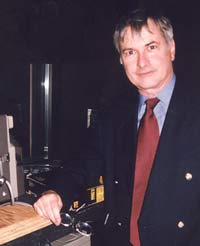
Seth Shostak The mission of the SETI (Search for Extraterrestrial Intelligence) Institute is to explore, understand and explain the origin, nature, prevalence and distribution of life in the universe.
Why do we think extraterrestrials might be "out there", how are we looking for them and what would we do if we found evidence of their existence? Those were some of the questions posed by the engaging speaker Seth Shostak, public programs scientist at the SETI Institute in California, at the second seminar in the University's series, "The Quest for Contact: In Search of Extraterrestrial Life". "If you asked 10 York astronomers if they believe there are aliens somewhere in space, probably nine would answer 'yes'. Not because they have proof but because of the vastness of space. There's a lot of cosmic real estate out there," said Shostak. He did the math: approximately one-in-10 stars are similar to our sun; the stars are arranged in galaxies, such as our Milky Way, and there are roughly 100,000 million galaxies; each galaxy has about 100,000 million stars; so there are around 10,000 billion, billion stars in the universe - "more than grains of sand on all the beaches in Canada". What all the math boils down to is the argument: why would our sun be the only special star in the universe to have planets with life on one of them. Shostak gave a quick run-down of the history of humankind's beliefs, starting with people who said the Earth was the centre of the universe. When that was disproved, people still believed that our sun was the centre of the galaxy. When that was disproved (our solar system is near the outer edge of the Milky Way), most of the world believed our galaxy was the only one in the universe. That, too, was shown to be inaccurate: ours is one of thousands of millions of galaxies. "Maybe we think we're special because of our intelligence, our biology or our culture; or perhaps we think we're morally special because we have a special relationship with God. But how would people feel if we suddenly received a signal from something extraterrestrial? In an instant, it would show that none of our beliefs of being special is true." Searching for other life So if it's unlikely that Earth is the only planet with life on it, how will we find out if other celestial objects have life? Starting with our own solar system, Shostak said astronomers say it is unlikely that Mars ever had "intelligent" biology even if there was once life on the planet. "If you want to find sentient life you would have to go to another solar system, and that is difficult to do. Our rockets go at 10 miles a second. At that speed it would take 70,000 years to reach the nearest star." Scientists had the idea of putting a "builders' plate" on the side of some rockets heading into space, in case they ever reached an extraterrestrial civilization. US astronomer Carl Sagan designed the plate with symbols of a man and woman, a simple map of where Earth is in the galaxy, showing relative distances to nearby pulsars (dead stars that flash lights and emit radio waves). Commented Shostak, "It was a good idea, but ineffectual. So is the idea of broadcasting messages to space aliens, which was done in 1974 from a telescope in Puerto Rico." Signals were sent to a globular cluster of stars in our galaxy that is 23,000 light years away. "Think about it: it would take 23,000 light years for the signal to reach the stars and 23,000 years to get a reply. You'd finally get an answer 46,000 light years after all the funding for the project had dried up, and it would be: 'Would you mind repeating that?' he quipped. "Seriously, it's clearly not the way to go." "Let ETs do the work" What, then, is the way to go? "Let ETs do the work of broadcasting and we'll listen," said Shostak. "Why? Because we've had radios for only about 100 years, but if there is intelligent life in space they might have had the technology for thousands or millions of years." He said Frank Drake, chairman of the board of the SETI Institute, had that idea in 1960 and put it into use. Drake pointed an antenna at "sunlight" stars about 12 light years away, and for a few weeks he listened for signals. Although no ET signals were picked up, "it was an interesting idea", said Shostak, who is now involved with Project Phoenix through the SETI Institute. The Phoenix Project is the world's most comprehensive search for extraterrestrial intelligence. Scientists listen for radio signals that are either being deliberately beamed our way, or are inadvertently transmitted from another planet. It began in Australia in 1995 studying stars in the southern hemisphere, then moved to the United States where observers could monitor stars in the northern hemisphere. Now, using sophisticated computers and a 300-metre radio telescope at Arecibo in Puerto Rico, which is trained on stars 150 to 200 light years away, astronomers look for radio signals between 1,000 and 3,000 MHz on the radio dial during two, three-week sessions each year. Such narrow band signals are the signature of intelligent transmission, explained Shostak. If researchers receive what could be an ET signal, they contact astronomers at Jodrell Bank Observatory in England, who then train their large antenna onto the same star. If they are unable to pick up the signal, it means that the signal was likely due to something else. Have astronomers picked up signals from ETs yet? So far, no. They have had a few false positives, but these have all been terrestrial interference, including telecommunications satellites, military radar etc. Looking for flashing lights "Another way we could be searching for ETs in situ is by looking for flashing lights," said Shostak, adding that Shelley Wright at the University of California, Santa Cruz, has developed a box that connects to a telescope and looks for bursts of photons coming from nearby stars. "Maybe aliens are flashing us. If you were to aim a powerful laser at a star and flash it for a nanosecond it would make a flash of light that would outshine our sun." To date, Project Phoenix has investigated flashes from a few thousand stars. Can Shostak estimate the chances of astronomers locating ETs? "Not really. The equation depends on things we don't know. It depends on how many other worlds are out there. Remember: it has only been since 1995 that we've known there are any other planets outside of our solar system. So far we have found 80 such planets. "We believe there are stars with planets that might be able to sustain life, but not necessarily the movie version of intelligent extraterrestrial life. Do we really know if any planets could cook up DNA? We don't. We don't know how life got started here on Earth let alone anywhere else. Maybe 'biology' is rare." Another idea Shostak tossed to the audience was that perhaps humans are only here to "get the silicon going in the form of artificial intelligence - a "thinking machine". If we designed such a machine, he said, the first thing people would do is ask it to design something smarter than itself, and each successive machine would build an even more intelligent one. This would result in a machine with an enormous IQ running this planet, "and then maybe it would get up and leave in search of more matter, more energy at the centre of the galaxy. "Perhaps this happened at some point in the galaxy within the last few billion years and, if SETI were to pick up a radio signal it would be from a machine that is in the service of another machine, not from a humanoid ET that some of us imagine an alien to be." In summing up, Shostak said many researchers believe they will receive an ET signal by 2020. He explained: with private funds, the SETI Institute is building the Allen telescope made of 350 receiving dishes, each about six metres in diameter, that they'll be able to use around the clock throughout the year. It will be able to map galaxies and check at least three stars at a time and listen to 200 million channels at once - which is 100 times faster than what is happening currently. By the year 2006 it will have checked 1,000 stars. By 2020 it will have scanned several million nearby stars at which time, applying a nominal value of N (the number of broadcasting civilizations), chances are it will have found an ET signal. The problem Shostak foresees then is how would humans 'read' any such signal? "We would need a 'Rosetta Stone' to be able to understand the message. But I still think it's worth the candle," he said, ending his talk on an optimistic note. "The Quest for Contact: In Search of Extraterrestrial Life" is a seminar series at York presented by the Science and Society Program and Bethune College and sponsored by the Office of the Vice-President Academic and the Division of Humanities.
| ||
|
|
York staff member's unusual hobby: ETs By Cathy Carlyle 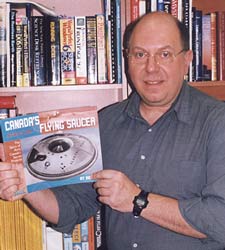
Nick Balaskas Nick Balaskas, lab technician in the Department of Physics, Faculty of Pure and Applied Science, has an unusual hobby: searching for signs of extraterrestrials. He gets calls from the public, the media and the police force for help in investigating sightings of UFOs and claims of alien abductions.Balaskas has had substances, which people claimed were implanted by aliens, analyzed in various labs. "Once, a sliver of metal was removed from a woman who believed she had been abducted by extraterrestrials. It was surgically removed from an area where previously no wound had been visible. "The metal was found to be iron, and investigators decided that it could have entered her body in a childhood accident. Shrapnel can move around the body and come out later far from where it entered. Still, it wasn't entirely ruled out that it could have been implanted by an extraterrestrial." Balaskas had another item analyzed at the University of Toronto. The report revealed that its physical and chemical properties were unusual. "But, unless it's stamped 'Made on Mars' it is hard to prove it's an extraterrestrial substance," he said. In his quest for facts about UFO phenomenon, he has checked the personal papers of researchers and examined documents at the National Archives of Ottawa and other archives, including those of scientist Omond Solandt, chancellor of the University of Toronto from 1965-1971, and founder and first Chair of the Defence Research Board. Solandt, who died in 1993, headed two Canadian government-sponsored UFO studies (Project Magnet and Project Second Storey) in close collaboration with the United States, said Balaskas. The results of these studies were never made public, and Balaskas has no explanation for the secrecy. He is continuing his own research, ever hopeful of finding solid evidence that aliens have visited Earth.
| ||
|
|
York affiliation strengthens Canada's online sustainability report
Canadians can expect the best and most up-to-date information on sustainability issues and trends now that Canada's first online Sustainability Report Program (SRP) has joined forces with the York Centre for Applied Sustainability (YCAS). On Dec. 14, SRP Founder Michael Keating and YCAS Director David V.J. Bell signed an agreement witnessed by Carol Irving, on behalf of York's Vice-President Research and Innovation Stan Shapson. The agreement cements long-standing ties. In 1998, Bell championed the establishment of the Web-based report at
www.sustreport.org
as part of YCAS's mission "to promote the application of the principles and practices of sustainability throughout society". The SRP is an independent report supported by public and private sectors. The York affiliation will mean continued support and access to expertise on sustainability, as Canadians face critical decisions on energy, transportation, resources and urban sprawl and prepare for the 2002 World Summit on Sustainable Development in Johannesburg.
| ||
|
|
New Year, new term - York President Lorna Marsden
York President and Vice-Chancellor Lorna R. Marsden is stepping over the threshold into her second term as president of the University. In this interview she takes the opportunity to share her thoughts about the past five years at York and her vision for the next five years.
Q: What do you see as the focus and highlights of your first term, and how will the second term differ?
A: My main focus was to bring together academic and accompanying strategies for the University so that we could all participate in them and understand them. Building on existing academic plans and the traditions of the first 40 years, which led to the focusing of the mission statement for the University, my goal was to ensure that our academic strengths continued. I also wanted us to put in place all the parts to make it an even more distinguished and strong university in Canada and internationally.
One of the key strengths built at York is an approach to university education that is contemporary in its values and directions but draws on the ancient values of universities, on their academic freedom and debate. For the contemporary nature of York's programs, teaching styles and research focus, we've gathered together students who want to participate in this.
Our alumni are our best guide to what we have created. We have wonderful alumni including an astonishing array of unusual and exciting careers. Look at Margot Franssen (president and partner of The Body Shop Canada) and Steve MacLean, (Canadian Space Agency astronaut). Why is it that these people have the courage and imagination to be leaders in their fields and make changes - to challenge convention? Well, I believe their experience at York University has contributed to that courage and strength.
As for the next five years, we will be in the run-up to our 50th anniversary in 2009. I will be retired before that, but I want my successor to be able to have a truly wonderful 50th anniversary to show the world what the faculty, alumni, staff and students have built at York. We have appointed Professor Michiel Horn (Glendon College) to prepare an official history of the University in time for 2009, but he and I are both hoping that many of our distinguished faculty and staff will be bringing out their own informal memoirs and histories so that the world understands what has been achieved in only half a century by this wonderful University.
Q: What are your thoughts about labour relations at York?
A: York has a large and diverse group of employees, as does every other university in Ontario, organized into a number of unions. I believe strongly in the orderly nature of negotiations which unions bring to employee/employer relationships, and the overwhelming majority of our negotiations clarify issues for both sides and create a good, positive atmosphere in the University. Sometimes they don't succeed and this is regrettable. But I believe the whole community is committed to good labour relations, and I certainly am.
Q: The "double cohort" in Ontario universities draws nearer. Can you give us an update on York's preparations for the extra influx of students expected in 2003?
A: Our strategy toward this phase of demographic growth has been clear for the past three years. We want to serve the students of this province and country as well as international students. We will admit numbers of students consistent with our academic programs and plan, with our resources to hire faculty and staff, and with our ability to provide the buildings and facilities necessary to ensure that students receive the very best education possible.
The government has made the following commitments. On the capital side, the SuperBuild program provides some - but not all - of the money to construct buildings. It is a fund-raising challenge of major proportions (to find the extra money needed). On the operating side, Dianne Cunningham (provincial minister of training, colleges and universities) has promised full average funding for the expected additional students. From the beginning we have said we would take students if those two conditions were met. At the present time we can say they have been met. But the double cohort starts in 2003 and until then we are keeping a close eye on developments.
Q: What do you see as some of the basic needs of students attending York?
A: In addition to the teaching and research that York has to offer, students need reassurances from governments at both levels that there will be opportunities for them to complete their education if they meet the academic standards. That includes reasonable levels of tuition, a stable and generous program of scholarships and bursaries, and a clear loans program so that they know in advance what they can expect. We are urging both levels of government to provide this.
In addition, for York students at the Keele campus the greatest other benefit would be frequent and fast public transit from the city by subway and from the York region. And we've been devoting a large amount of time to try and make this happen.
Q: How do you see York moving forward to achieve the University's Strategic Plan, given the financial constraints the University is facing?
A: The financial environment for the University is very challenging. We have had no funding for inflation since before I came to York. This is taking its toll on every university and certainly causes us serious problems. But I remind everyone that the Fair Funding Plan, under which York received $12 million in 1998, was a big boost to the University. Until then we had been receiving fewer dollars per student than some of the other universities with the same programs. And being in the Greater Toronto Area, we have wonderful opportunities to build with additional students who will bring full average funding, and will help us achieve our academic mission.
In addition, enrolment growth with the government's promised capital and full average funding will bring important new resources to York. The federal budget's indirect costs for research is a very significant step forward.
I also want to say that I would like to see whoever leads this province make the same strong commitment to publicly-assisted universities that the previous governments of Ontario made in the 1960s and 1970s. I believe that public universities are a bedrock institution in civil society and need the protection of governments who understand their significance in our culture, our democracy and our economy.
Q: The President's Task Force on Sustainability was begun in 2000. How you expect it to influence the growth of the York campuses?
A: We are pleased with the recommendations of the task force as our executive response shows. (See
http://www.yorku.ca/president/initiatives
re Report on the President's Task Force on Sustainability and the Executive Response.) We have worked hard at the University to reduce our ecological footprint and will continue to do so. We have the wonderful new, energy-conserving and highly-innovative Computer Science Building that epitomizes our strong commitment to academic excellence and environmental sustainability. When it officially opens, we will sign the Talloires Declaration, adopted by many universities worldwide who have agreed to embed sustainability in the university research and curricula.
Q: What are York's plans regarding academic programming on the Internet?
A: Faculties and departments are always looking at the most effective ways of learning and teaching. They decide what creates the best opportunities for students in their fields. For instance, the exciting new Technology Enhanced Learning Building (where some classrooms will have 24-hour access to distance learning and the Internet) will provide all of us with the opportunity to learn about these possibilities.
People like me, who teach in a subject where large data bases are required, see two things: the need to train ourselves on how to use these wonderful electronic inventions effectively, and the potential to provide students with a hands-on experience that has never before been easily available to them. But each subject is different, and faculty members will ponder these opportunities and consider their students' interests.
Q: What other specific challenges face York within the next couple of years, and how are we preparing to meet these challenges?
A: York is a very large place and size brings strengths, for example, in the diversity of people, faculty and facilities that enrich the lives of the students and the community. Administratively, it brings all the challenges that go with a large university, which is also a not-for-profit corporation with complicated regulations and financial constraints.
Fortunately, we have a wonderful board of governors who devote countless volunteer hours to ensuring that we keep a high standard of administration and maintain our fiduciary duties. With dedicated administration throughout the University we are constantly thinking about how to organize ourselves to be effective and efficient in achieving our academic plan. For example, we are creating the York University Foundation, which is an independent corporation dedicated entirely to raising funds in support of our academic plan. This exciting venture will roll out in the first half of this year. (For more information see
York University Foundation moves forward
in this issue of The Gazette.)
In addition, vice-presidents Deborah Hobson and Phyllis Clark will be leaving this year and a certain amount of reorganization follows on the departure of key individuals. We try hard to keep the York community fully informed through both governing bodies as well as through the University Administrative Forum, our Web pages and such publications as The Gazette.
Q: Have you anything else you would like to add?
A: I love being able to attend the variety of activities that take place on the York campuses - student performances, sports events, Homecoming and all the United Way events.
And I want to say that I take enormous pleasure in working with so many students in a variety of ways: in the classroom, when I have a chance to teach, and through hundreds of casual encounters - in line-ups for lunch, at the bank and at the book stores. I make time every day to have some contact with at least one of our students. They are an inspiration and we all draw our strength from their generous contributions of ideas, volunteer activities and energy on our campuses and in the community.
| ||
|
|
York University Foundation moves forward
York University's advancement area is moving forward with a number of changes, as the new York University Foundation begins. The Foundation will soon be taking over responsibility for raising funds for the University in support of its academic mission.
The president and CEO of the Foundation will be Paul Marcus, who brings a strong track record of accomplishment in development work, most recently as senior vice-president of the Mount Sinai Hospital Foundation. He will join the Foundation in March 2002, and will also serve as vice-president development of the University.
With the establishment of the Foundation, the departments in the advancement area are being reorganized, and will no longer function as the Advancement Division.
The Development group will continue to work under the direction of Marie-Thérèse Chaput until Paul Marcus begins at the Foundation. The Advancement Services group, however, will report through Josie Zappulla to Gary Brewer and work is underway to define the organization.
A transition team has been established to provide regular information and take into account the complexities of this reorganization. The team is chaired by President Marsden and Maria Wacyk, executive director of human resources, and includes the directors of alumni affairs, communications, development, and media relations, and representatives from human resources and student services.
Alumni Affairs will move to the Division of Enrolment and Student Services reporting through Vice-President Deborah Hobson.
Janice Nathanson has been appointed special senior advisor to the president through April, conducting a review of the University's communications and marketing activities and needs. Working with everyone in the departments across the University, she will help create and implement an effective structure for a decentralized communications and marketing program driven by a single strategy, a common identity, and consistent themes and messaging.
In the meantime, Communications and Media Relations will report to the president through Cim Nunn.
| ||
|
|
In Brief
Joel Lexchin part of research team for Romanow Commission Joel Lexchin of Atkinsons School of Health Policy and Management has been chosen to be part of a consortium that has been granted the contract for research on globalization for the Romanow Commission on health. The consortium is composed of university professors, members of the North-South Institute and the Canadian Centre for Policy Alternatives. They will be delivering their final report to the commission in June. The commission itself is examining the long-term challenges of maintaining the public, universal health care system in Canada, including changing demographics, rising costs, and new technologies. It will be recommending policies and programs to balance health maintenance with care and treatment.
Another Grammy nomination for York Professor Rob Bowman Rob Bowman, nicknamed York's rock 'n' roll professor, has just received his fifth Grammy nomination, this one in the Best Album Notes category.
The nomination is for the essay he wrote to accompany the four CD box set The Stax Story, which he also co-produced. The 44th Annual Grammy Awards will be announced in the Grammy telecast on Feb. 27. The Grammy, the recording industry's most prestigious award is presented by the Recording Academy and honours excellence in the recording arts and sciences.
| ||
|
|
Visual Arts grad students display their creations "Sincerely"
The future of the visual arts community is here. In January, York's visual arts graduate students mounted "Sincerely", a group exhibition of their creative work at the Joan & Martin Goldfarb Centre for Fine Arts gallery. Paintings, installations, sculpture and photography - all captured the eye. Pictured here are Christine Carson's mixed media, "light, fragile objects offer no resistance" (Photo #1); P. Roch Smith's "tilt" of bronze, steel and wood with Vanessa Eidse's series "Latin Lessons for Beginners" (Photo #2) beside it; and Chris Ironside's mixed media work, "Charms" (Photo #3).
| ||
|
|
Babies have sophisticated memory and recall says York prof.
Professor Scott Adler's psychology research at York University is certainly not child's play. In fact, what he is trying to prove is that our babies have a very sophisticated system of memory and recall, an assertion that not all psychologists agree with.
Adler explains that there are many types of memory. Two types are "short-term" or everyday memory, used for tasks like dialing a phone, and "long-term", which is used to retrieve information years later. He tells us, "Those particular brain areas that serve those memory functions, are functionally immature. So these are types of memory it has been proposed infants don't have. I don't believe that. Those brain areas are there, those neurons are firing, so they have to be doing something."
Of course, one of the problems in this type of research is that infants cannot speak for themselves. Adler believes that is one of the reasons this research area is so exciting. "You have to be really creative," he says, "to try to get the infants to tell you what is going on in their heads without any language. And you have to design the experiment well so you can be sure what they are giving you is actually what is going on in their heads, and not something different that you are interpreting wrong."
Different methods have been created to try to measure memory in infants, but the downfall of most of them is that they measure merely the amount of time infants spend in concentrating on an image. These older methods seek to prove that as the attention span of the infant decreases - in essence, as they get bored with something - they must be "remembering" it. However, Adler believes that there is something more important to be measured in the eye movements that babies make between images, concentrating on "future-orientated expectations". That is to say: in order for an infant to expect or predict what will happen in the future, information must have been stored in its memory.
"What we do is present a sequence of pictures on the left and right sides of a screen," he explains. "The pictures vary in colour and pattern. There's no predictability to the pictures themselves, just the location on the screen. The pictures last less than a second, and then in between the pictures the screen is absolutely blank: they have nothing to look at.
"Initially what they'll do when a picture comes up in a completely dark room is that the infant will make an eye movement to the picture to look at it - that's the job of infants on this planet: to look at things and learn about them. What happens is that very quickly they learn this pattern, and after one picture goes off and before another comes on, they make an eye movement to the new location. They are actually predicting where the next picture will come up." Part of what Adler is in the process of proving is that not only do babies have an expectation of where and when something will occur, they actually have the cognitive sophistication to predict what will appear as well.
The Natural Sciences and Engineering Research Council of Canada (NSERC) has made it possible for Adler to pursue this research. Their award has enabled York University to purchase specialized equipment to measure infants' eye movements, as well as fund a four-year project using this equipment. With the help of his graduate assistant, Jazmine Orprecio, and two specially selected undergraduates, Adler is very excited to see the results of this new research.
Of what importance is this to the public at large? Aside from attracting attention to our cutting-edge Canadian research - which is very important for attracting collaborators and guest lecturers from abroad - Adler foresees a day when his research can be used for extremely early diagnosis of cognitive problems such as Attention Deficit Hyperactivity Disorder. "Imagine," he says, "if we could diagnose this at three months of age, instead of at eight or nine years. We could really help these children. That possibility exists."
So do you want to find out the incredible cognitive abilities of your baby? See him/her processing information at a sophisticated level? Adler is always happy to hear from parents of newborns who are willing to participate in his studies, and in fact there is a small honorarium involved in participation. Those interested in having their infants involved can contact Adler at 416-736-5115 ext. 33389, or e-mail
adler@yorku.ca
. More information can be found on his Web site
www.psych.yorku.ca/adler
.
Derek Irwin is a master's student in English and writer in York University's SPARK (Students Promoting Awareness of Research Knowledge) program. The program was initiated by NSERC (the Natural Sciences and Engineering Research Council of Canada) in 1999, based on a model developed at the University of Guelph.
| ||
|
|
From the archives: Linda McQuaig
ASC (Archives and Special Collections) donor Linda McQuaig talks about her new book
"I'm really trying to talk about the New Capitalism as a kind of transfer of powers to corporations, a kind of move away from the idea that there should be a strong role for government defending the public good and regulating the economy and private interests and that sort of thing," comments McQuaig on the phone from Winnipeg as part of her promotional tour for the book. "I talk a lot about the trade deals and how they are just sort of support for corporate power and I talk about some of the evidence of what impact this is having both here and around the world."
Central to All You Can Eat is the work of the late Karl Polanyi whose own questions about the essential nature of human beings helped McQuaig in her examination of the supposed inevitability of the shift to the New Capitalism. McQuaig made use of Polanyi's personal papers housed at Concordia University in Montreal in researching her latest work. Her own archival papers, though, including personal and business correspondence, note books, manuscript and typescript drafts of many of her works as well as copies of essays and papers written while she was a student reside at York University Archives.
"I remember years ago reading The Great Transformation. It sort of takes you beyond the normal critique from the Left," muses McQuaig. "You can get into this debate about what works better and how big the public system should be. It strikes me that Polanyi approaches these problems in a much more profound way by sort of going to the root of some of these issues to sort of raise questions about whether or not the society we are in is even compatible with our own human nature.
"In a sense, some of the stuff that interests me [with Polanyi] is the stuff to do with 'is this all inevitable because this is the nature of the human personality', that we're primarily driven by greed and material acquisitiveness - end of story. Or is that a fundamental misreading and a decision of what we are expected to be like under capitalism?" McQuaig adds, "Polanyi's point about how we are all social beings gets into the question of 'is the approach we are taking undermining our own self interest?'"
Linda McQuaig
"[Polanyi] makes the point that the Marxist and capitalist systems agree that material acquisitiveness is the basic motivator in human society and that they simply argue about how society should be organized around that but," explains McQuaig, "he takes a different approach. When he talks about capitalism and points out that capitalism on its own creates such massive inequalities and vulnerabilities, it is inevitable that people will band together to resist it. That's a very interesting interpretation of history.
"I think it's true. You can focus on this ever evolving capitalism but all along the way, there's been this sort of resistance to it. In a sense, when you talk about all this globalization being inevitable, one possible conclusion one could draw from Polanyi is that it's also probably inevitable that there is going to be some sort of counter reaction to it because it creates such displacement and disruption in people's lives and the lives of their community."
Through her books, her bi-weekly column in The National Post and her public talks, McQuaig has been an active agent in increasing public awareness of the issues and the challenges that face civil society today. While much of what is written tends to put a simplistic spin on the decisions made by our governments, McQuaig offers a more holistic set of perspectives.
"I think we often get confused between the sort of rhetoric we see in the media and the kind of things that ordinary people feel. The amazing thing is that we have the example of the American health care system south of the border (which is 40 per cent more expensive per capita than our publicly funded model) which is a disaster and yet so rarely is the example brought out. The media doesn't bring that out. In this whole debate we've been having about how to reform our health care system, there aren't constant horror stories about what happens when you privatize the way the Americans have."
Sean Smith is Archivist's Assistant with York University Archives and Special Collections.
| ||
|
|
York's Spanish Resource Centre commemorates architect Gaudí
York's Spanish Resource Centre held a series of events in commemoration of the 150th anniversary of the birth of prestigious Spanish architect Antonio Gaudí. There were talks about Gaudí on the Glendon campus. In addition, on the Keele campus there was a photographic exhibition by Eliseu Oriol, an expert on the architect, and labour/social affairs councillor at the Embassy of Spain in Washington, DC, and an oil-painting exposition of Gaudí's works by Jordi Clement, a Spanish citizen living in Brussels. Pictured here is Oriol's photo of the Sagrada Familia, a building which was begun in 1883 and is still in progress. The exhibit highlighted details of Gaudí's creations, "because each of his buildings is formed by a sum of small and large details that can be singled out, details that sometimes one does not even become aware of when looking at the whole structure," said Oriol.
| ||
|
|
York's Faculty of Education participates in project looking at inclusive education
Patty Gillis, Chair of the Ontario Coalition for Inclusive Education presents Paul Axelrod, dean of York's Faculty of Education with a portrait that was created by students at the workshop.
York University's Faculty of Education recently partnered with the Ontario Coalition for Inclusive Education to work on a project entitled All Teachers! All Students!
The project, which was funded through the Community Inclusion Projects managed by the Ontario Association for Community Living, was an initiative to encourage and work with Faculties of Education to restructure teacher-training programs across Ontario by strengthening attention to inclusive education. The project focused on the education system and the right of students with developmental and other disabilities to attend regular classes in neighbourhood schools.
Coordinating the project was Angela Valeo, a doctoral student in the Faculty of Education. Leaders selected from communities around the province where a faculty of education is located were brought together for a weekend training workshop where they received information about faculties of education, resources for inclusion of value to teachers, and local school systems.
Participants were made up of parents and siblings of individuals with disabilities, university students, local advocacy organizations and members of People First of Ontario, an organization of people with developmental disabilities. The workshop was designed to encourage leaders to return to their communities to set-up a committee that would meet with their local Faculty of education to offer information and resources as well as to have discussions about how they can better prepare their teaching candidates to effectively meet the needs of diverse learners.
York University's Faculty of Education has been one of the most responsive and progressive groups involved in this project. The Faculty has introduced elements of inclusive education into its curriculum for all teaching candidates.
The major goals and objectives of the project were:
Anderson Coward is the communications coordinator with the Faculty of Education at York University.
| ||
|
|
York Perspectives
From the Department of Communications comes this familiar York perspective - an undergraduate class morning lecture.
| ||
|
|
|||
|
|
|
| Current Issue | Previous Month | Past Issues | Rate Card | Contact Information | Search |
|

